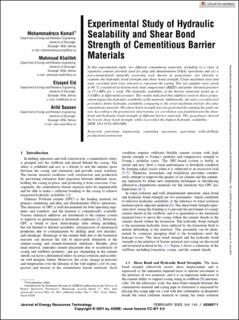| dc.contributor.author | Kamali, Mohammadreza | |
| dc.contributor.author | Khalifeh, Mahmoud | |
| dc.contributor.author | Eid, Elsayed | |
| dc.contributor.author | Saasen, Arild | |
| dc.date.accessioned | 2021-07-05T07:50:24Z | |
| dc.date.available | 2021-07-05T07:50:24Z | |
| dc.date.created | 2021-06-09T12:49:08Z | |
| dc.date.issued | 2021-06 | |
| dc.identifier.citation | Kamali, M., Khalifeh, M., Eid, E., & Saasen, A. (2021) Experimental Study of Hydraulic Sealability and Shear Bond Strength of Cementitious Barrier Materials. Journal of energy resources technology, 144(2), 023007 | en_US |
| dc.identifier.issn | 0195-0738 | |
| dc.identifier.uri | https://hdl.handle.net/11250/2763282 | |
| dc.description.abstract | In this experimental study, two different cementitious materials, including (i) a class of expansive cement currently used for plug and abandonment (P&A) operations and (ii) a non-cement-based naturally occurring rock, known as geopolymer, are selected to examine the hydraulic bond strength and shear bond strength. Clean machined steel and rusty corroded steel were selected to represent the casing. The test samples were cured at 90 °C considered as bottom-hole static temperature (BHST) and under elevated pressure of 17.2 MPa for 1 week. The hydraulic sealability of the barrier materials tested up to 3.4 MPa of differential pressure. The results indicated that additives used in slurry preparation impact the hydraulic sealability of the material. Additionally, the rusty corroded steel provided a better hydraulic sealability comparing to the clean machined steel for the same cementitious material. The shear bond strength test was performed by running the push-out test. According to the present test observations, no correlation was found between the shear bond and hydraulic bond strength of different barrier materials. The geopolymer showed the lowest shear bond strength, while it provided the highest hydraulic sealability. | en_US |
| dc.language.iso | eng | en_US |
| dc.publisher | Asme (The American Society of Mechanical Engineers) | en_US |
| dc.rights | Navngivelse 4.0 Internasjonal | * |
| dc.rights.uri | http://creativecommons.org/licenses/by/4.0/deed.no | * |
| dc.subject | petroleumsteknologi | en_US |
| dc.subject | brønnteknologi | en_US |
| dc.subject | boreteknologi | en_US |
| dc.title | Experimental Study of Hydraulic Sealability and Shear Bond Strength of Cementitious Barrier Materials | en_US |
| dc.type | Peer reviewed | en_US |
| dc.type | Journal article | en_US |
| dc.description.version | publishedVersion | en_US |
| dc.rights.holder | © 2021 by ASME | en_US |
| dc.subject.nsi | VDP::Teknologi: 500::Berg‑ og petroleumsfag: 510::Petroleumsteknologi: 512 | en_US |
| dc.source.volume | 144 | en_US |
| dc.source.journal | Journal of energy resources technology | en_US |
| dc.source.issue | 2 | en_US |
| dc.identifier.doi | 10.1115/1.4051269 | |
| dc.identifier.cristin | 1914805 | |
| dc.source.articlenumber | 023007 | en_US |
| cristin.ispublished | true | |
| cristin.fulltext | original | |
| cristin.qualitycode | 1 | |

